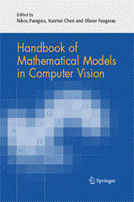|
When attending a general computer vision conference like xCCV, did you ever feel lost at certain sessions? Well, don’t always blame the presenters! The field covered by Computer Vision has become so broad that it is almost impossible to understand what is going on and to keep track of the latest developments. To (partially) overcome this problem, the editors of the Handbook of Mathematical Models in Computer Vision have done a great job. One can become a bit skeptical reading such a title. How complete can such a handbook be? However, going through the 33 chapters, indeed a wide breadth is treated. The focus of the book is on mathematical methods that both model and reproduce human visual abilities. This is the field of biological vision in which the editors have a strong background. The editors chose three distinct categories of mathematical models, namely variational techniques (those attending Prof. Faugeras’ talk at ICPR 2006 may remember his statement that they give the fundamental equations in computer vision!), statistical methods, and combinatorial approaches. The chapters are grouped in six sections that circle around these three categories. Although going through the book chapters by mentioning keyword may yield a rather boring list, it shows the wide variety of topics that are being dealt with. The book starts with a section on low-level vision: Image Reconstruction. Here one can find information on diffusion filters and wavelets, total variation methods, and PDE based inpainting. The second section is concerned with Boundary Extraction, Segmentation and Grouping. Here subjects like levelings, graph cuts, minimal paths and fast marching methods, deformable models, variational segmentation with shape priors, curve propagation, level set methods, and a stochastic model of geometric snakes are discussed. Section three switches to high level vision. It deals with Shape Modeling & Registration, divided into topics concerning invariant processing and occlusion resistant recognition, image-based inferences, point matching and uncertainty-driven, point-based image registration. In the fourth section, Motion Analysis, Optical Flow & Tracking, the concept of time is added and one encounters the topics of optical flow estimation, image warping, alignment and stitching, visual tracking, image and video segmentation, human motion capture, and dynamic textures. Section five deals with 3D from Images, Projective Geometry & Stereo Reconstruction, treated by boundary detection, stereo, texture and color, shape from shading, calibration, motion and shape recovery, multi-view reconstruction, binocular stereo with occlusions, and modeling non-rigid dynamic scenes. The last section may seem a bit odd: Applications: Medical Image Analysis. However, this is one of the most prominent areas in computer vision. Although here certain vision aspects do not occur, compared to natural images (just think of the influence of the sun), for many tasks the performance of the mathematical methods can be evaluated since a ground truth is often available – provided by humans whom the models are supposed to mimic. In this section, applications of interactive graph-based segmentation methods, 3D active shape and appearance models, characterization of diffusion anisotropy, segmentation, variational approaches, and statistical methods of registration are given. The danger of publishing an edited volume is the difference in style and treatment of the topics among the various contributions. This is not the case here. Each chapter gives a general introduction to the topic, introduces the mathematical model, discusses the underlying ideas globally, and shows some results. For the full details the readers are referred to the extensive bibliography with 929 entries. This book is a must-have for those interested in the full breadth of research done in the biological & computer vision community. As a bonus, the chapters can also be used in a seminar-based, advanced undergraduate course in mathematical based computer vision. |
|
BOOKSBOOKSBOOKS
Handbook of Mathematical Models in Computer Vision by Nikos Paragios, Yunmei Chen, and Olivier Faugeras (Editors) Springer, 2006
Reviewed by: Arjan Kuijper |


|
Click above to go to Nikos Paragios’ web page where there are links to information about the editors and contributors, to selected sections of the book and to sites that sell the book. |


|
Book Reviews Published in the IAPR Newsletter
The Geometry of Information Retrieval by van Rijsbergen
Biometric Inverse Problems by Yanushkevich, Stoica, Shmerko and Popel
Correlation Pattern Recognition by Kumar, Mahalanobis, and Juday
Pattern Recognition 3rd Edition by Theodoridis and Koutroumbas
Dictionary of Computer Vision and Image Processing by R.B. Fisher, et. Al
Kernel Methods for Pattern Analysis by Shawe-Taylor and Cristianini
Machine Vision Books
CVonline: an overview
The Guide to Biometrics by Bolle, et al
Pattern Recognition Books Jul. ‘04 [pdf] |